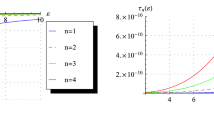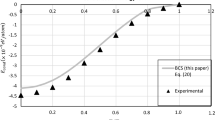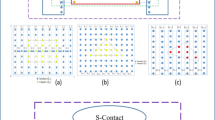Abstract
If electrons (e) and holes (h) in metals or semiconductors are heated to the temperatures \(T_\mathrm{e}\) and \(T_\mathrm{h}\) greater than the lattice temperature, the electron–phonon interaction causes energy relaxation. In the non-uniform case a momentum relaxation occurs as well. In view of such an application, a new model, based on an asymptotic procedure for solving the kinetic equations of carriers, phonons, and photons, is proposed, which gives naturally the displaced Maxwellian at the leading order. Several generation–recombination (GR) events occur in bipolar semiconductors. In the presence of photons the most important ones are the radiative GR events, direct, indirect, and exciton-catalyzed. Phonons and photons are treated here as a participating species, with their own equation. All the phonon–photon interactions are accounted for. Moreover, carrier–photon (Compton) interactions are introduced, which make complete the model. After that, balance equations for the electron number, hole number, energy densities, and momentum densities are constructed, which constitute now a system of macroscopic equations for the chemical potentials (carriers), the temperatures (carriers and bosons), and the drift velocities (carriers and bosons). In the drift–diffusion approximation the constitutive laws are derived and the Onsager relations recovered, even in the presence of an external magnetic field.
Similar content being viewed by others
References
Rossani, A.: Modeling of the non-equilibrium effects by high electric fields in small semiconductor devices. Phys. A 390, 3329–3336 (2011)
Koponen, I.: Thermalization of an electron–phonon system in a non-equilibrium state characterized by fractal distribution of phonon excitations. Phys. Rev. E 55(6), 349 (1997)
Allen, P.B.: Theory of thermal relaxation of electrons in metals. Phys. Rev. Lett. 59(13), 1460 (1987)
Anile, A.M., Pennisi, S.: Thermodynamic derivation of the hydrodynamical model for charge transport in semiconductors. Phys. Rev. B 46(20), 13186 (1992)
Marcowich, P.A., Ringhofer, C.A., Schmeiser, C.: Semiconductor Equations. Spriger, Wien (1990)
Rossani, A.: Exciton-catalyzed generation-recombination of electrons and holes in semiconductors: a kinetic approach. Mod. Phys. Lett. B 26, 1250072 (2012)
Ben Abdallah, N., Degond, P., Genyeis, S.: An energy-transport model for semiconductors derived from the Boltzmann equation. J. Stat. Phys. 84(1–2), 205 (1996)
Ben Abdallah, N., Degond, P.: On a hierarchy of macroscopic models for semiconductors. J. Math. Phys. 37(7), 3306 (1996)
Rossani, A.: Generalized kinetic theory of electrons and phonons. Phys. A 305, 323 (2002)
Lifshitz, E.M., Pitaevskii, L.P.: It Physical Kinetics. Pergamon Press, Oxford (1981)
Davydov, A.: Theorie du solide. Mir, Moscou (1976)
Ziman, J.M.: Electrons and Phonons. Clarendon Press, Oxford (1950)
Rossani, A.: A three-fluid approach in bipolar semiconductors with generation-recombination: constitutive laws and Onsager symmetry. Continu. Mech. Thermodyn. 28, 1671–1682 (2016)
Lundstrom, M.: Fundamentals of Carrier Transport. CUP, Cambridge (2009)
de Groot, S.R., Mazur, P.: Non-equilibrium Thermodynamics. Dover, New York (1983)
Muscato, O.: The Onsager reciprocity principle as a check of consistency for semiconductor carrier transport models. Phys. A 289, 422 (2001)
Mascali, G.: Maximum entropy principle in relativistic radiation hydrodynamics II: Compton and double Compton scattering Continu. Mech. Thermodyn. 14(6), 549 (2002)
Mascali, G.: A hydrodynamical model for silicon semiconductors including crystal heating. Eur. J. Appl. Math. 26, 477 (2015)
Romano, V., Zwierz, M.: Electron–phonon hydrodynamical model for semiconductors. Z. Angew. Math. Phys. 26, 1111 (2010)
Mascali, G., Romano, V.: Exploitation of the maximum entropy principle in mathematical modeling of charge transport in semiconductors. Entropy 19(1), 36 (2017)
Mascali, G., Romano, V.: Charge transport in graphene including thermal effects. SIAM J. Appl. Math. 77, 593 (2017)
Author information
Authors and Affiliations
Corresponding author
Rights and permissions
About this article
Cite this article
Rossani, A. A complete multifluid model for bipolar semiconductors, with interacting carriers, phonons, and photons. Z. Angew. Math. Phys. 68, 130 (2017). https://doi.org/10.1007/s00033-017-0875-8
Received:
Revised:
Published:
DOI: https://doi.org/10.1007/s00033-017-0875-8




